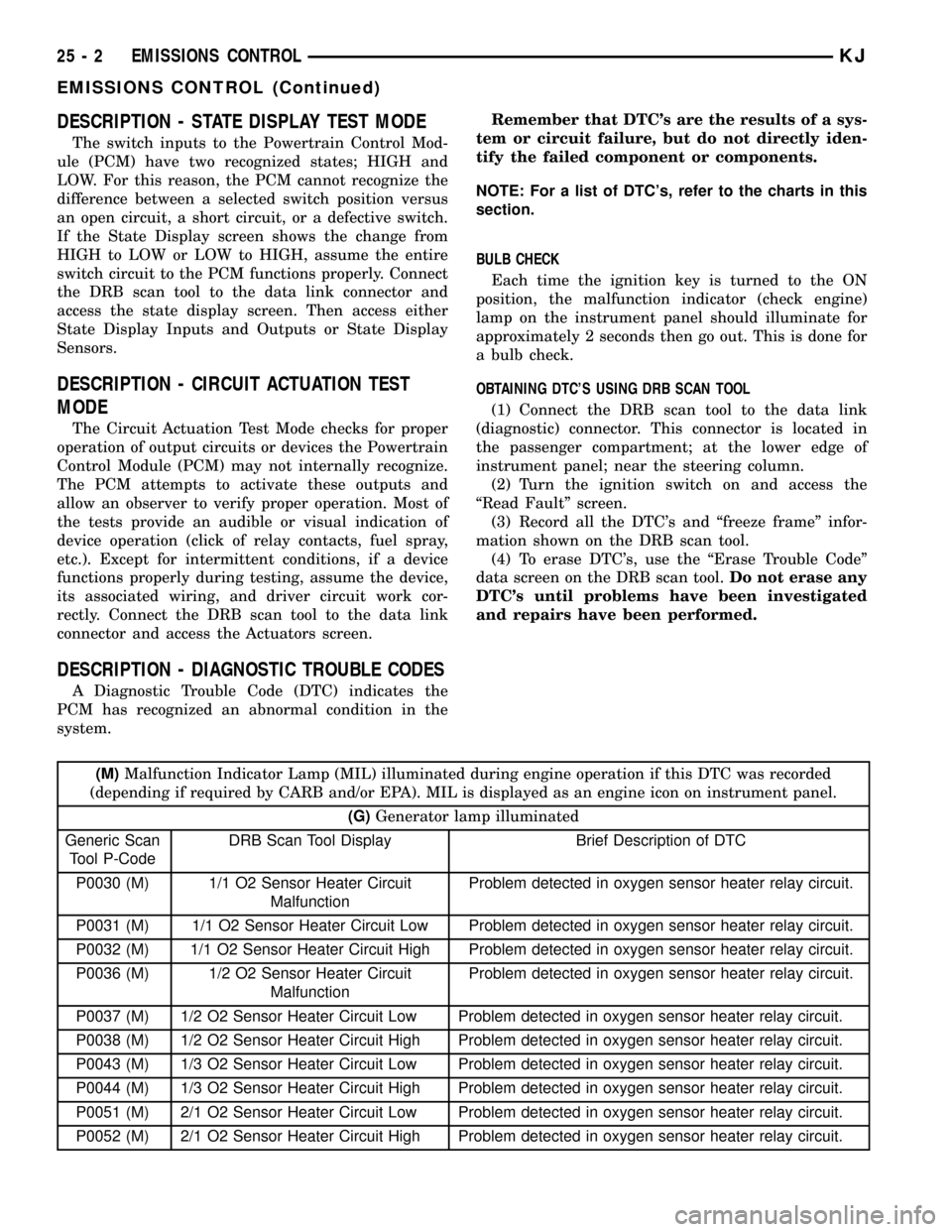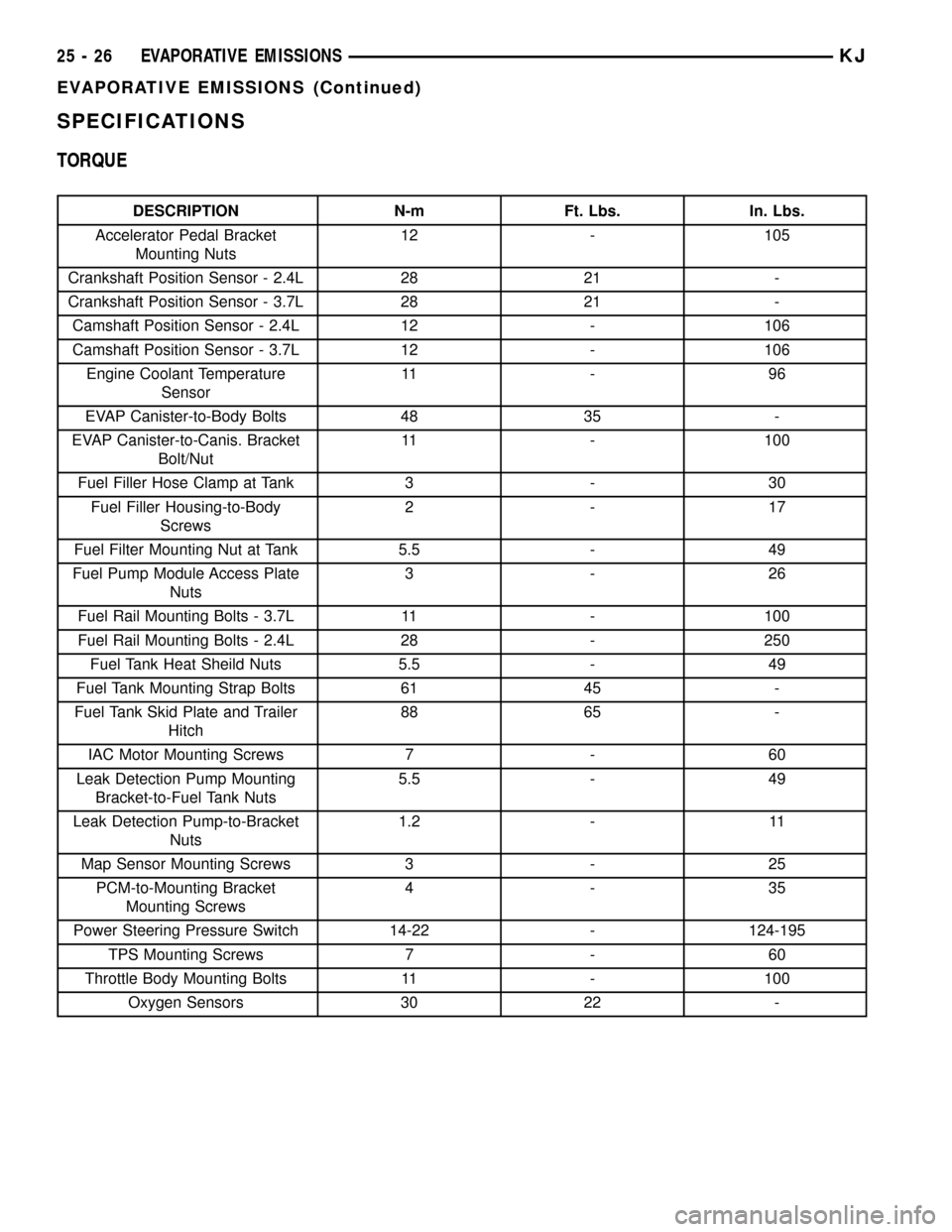2002 JEEP LIBERTY power steering
[x] Cancel search: power steeringPage 1672 of 1803

(2) Install and tighten the a/c low pressure switch
on the accumulator fitting. The switch should be
hand-tightened onto the accumulator fitting.
(3) Plug the wire harness connector into the a/c
low pressure switch.
(4) Connect the battery negative cable.
BLEND DOOR ACTUATOR
REMOVAL
WARNING: ON VEHICLES EQUIPPED WITH AIR-
BAGS, DISABLE THE AIRBAG SYSTEM BEFORE
ATTEMPTING ANY STEERING WHEEL, STEERING
COLUMN, OR INSTRUMENT PANEL COMPONENT
DIAGNOSIS OR SERVICE. DISCONNECT AND ISO-
LATE THE BATTERY NEGATIVE (GROUND) CABLE,
THEN WAIT TWO MINUTES FOR THE AIRBAG SYS-
TEM CAPACITOR TO DISCHARGE BEFORE PER-
FORMING FURTHER DIAGNOSIS OR SERVICE. THIS
IS THE ONLY SURE WAY TO DISABLE THE AIRBAG
SYSTEM. FAILURE TO TAKE THE PROPER PRE-
CAUTIONS COULD RESULT IN AN ACCIDENTAL
AIRBAG DEPLOYMENT AND POSSIBLE PERSONAL
INJURY.
(1) Disconnect and isolate the battery negative
cable.
(2) Remove A/C housing from vehicle(Refer to 24 -
HEATING & AIR CONDITIONING/DISTRIBUTION/
HVAC HOUSING - REMOVAL).
(3) Remove the screws that secure the blend door
actuator to the top of the HVAC housing. (Fig. 14).
(4) Remove the blend door actuator.
INSTALLATION
(1) Install the blend door actuator in place.
(2) Install and tighten the screws that secure the
blend door actuator to the housing. Tighten the
mounting screws to 2.4 ( .34) N´m (21 ( 3) in. lbs.).
(3) Install the HVAC housing into the vehicle(Re-
fer to 24 - HEATING & AIR CONDITIONING/DIS-
TRIBUTION/HVAC HOUSING - INSTALLATION).
(4) Install the blend door actuator electrical con-
nector from the wiring harness through the glove
box.
(5) Connect the battery negative cable.
BLOWER MOTOR RELAY
DESCRIPTION
The blower motor relay is a International Stan-
dards Organization (ISO)-type relay. The relay is a
electromechanical device that switches battery cur-
rent from a fuse in the Power Distribution Center
(PDC) directly to the blower motor. The relay is ener-
gized when the relay coil is provided a voltage signal
by the ignition switch. (Refer to 24 - HEATING &
AIR CONDITIONING/CONTROLS/BLOWER
MOTOR RELAY - DIAGNOSIS AND TESTING)
OPERATION
The blower motor relay is installed in a wire har-
ness connector that is secured to the passenger side
outboard end of the HVAC housing in the passenger
compartment, next to the HVAC wire harness con-
nector.
The blower motor relay cannot be repaired and, if
faulty or damaged, it must be replaced.
Fig. 14 HEATER CORE REMOVAL/INSTALLATION
1 - HEATER CORE
2- MOUNTING SCREW HOLE
3- INLET AND OUTLET TUBES
4- VACUUM HARNESS
5- ACTUATOR SCREWS (3)
6- ELECTRIC BLEND DOOR ACTUATOR
7- MOUNTING SCREW HOLE
8- HEATER CORE RETAINER TABS (4)
24 - 20 CONTROLSKJ
A/C LOW PRESSURE SWITCH (Continued)
Page 1673 of 1803

DIAGNOSIS AND TESTING - BLOWER MOTOR
RELAY
WARNING: ON VEHICLES EQUIPPED WITH AIR-
BAGS, DISABLE THE AIRBAG SYSTEM BEFORE
ATTEMPTING ANY STEERING WHEEL, STEERING
COLUMN, OR INSTRUMENT PANEL COMPONENT
DIAGNOSIS OR SERVICE. DISCONNECT AND ISO-
LATE THE BATTERY NEGATIVE (GROUND) CABLE,
THEN WAIT TWO MINUTES FOR THE AIRBAG SYS-
TEM CAPACITOR TO DISCHARGE BEFORE PER-
FORMING FURTHER DIAGNOSIS OR SERVICE. THIS
IS THE ONLY SURE WAY TO DISABLE THE AIRBAG
SYSTEM. FAILURE TO TAKE THE PROPER PRE-
CAUTIONS COULD RESULT IN AN ACCIDENTAL
AIRBAG DEPLOYMENT AND POSSIBLE PERSONAL
INJURY.
RELAY TEST
The blower motor relay (Fig. 15) is located in the
PDC which is located under the hood.. Remove the
relay from the PDC to perform the following tests:
(1) A relay in the de-energized position should
have continuity between terminals 87A and 30, and
no continuity between terminals 87 and 30. If OK, go
to Step 2. If not OK, replace the faulty relay.
(2) Resistance between terminals 85 and 86 (elec-
tromagnet) should be 60.7 to 80.3 ohms. If OK, go to
Step 3. If not OK, replace the faulty relay.
(3) Connect a battery to terminals 85 and 86.
There should now be continuity between terminals
30 and 87, and no continuity between terminals 87A
and 30. If OK, see the Relay Circuit Test. If not OK,
replace the faulty relay.
RELAY CIRCUIT TEST
For circuit descriptions and diagrams, (Refer to
Appropriate Wiring Information).
(1) The relay common feed terminal cavity (30) is
connected to fused battery feed directly from a fuse
in the Power Distribution Center (PDC), and should
be hot at all times. Check for battery voltage at the
connector cavity for relay terminal 30. If OK, go to
Step 2. If not OK, repair the open circuit to the PDC
fuse as required.
(2) The relay normally closed terminal cavity (87A)
is not used for this application. Go to Step 3.
(3) The relay normally open terminal cavity (87) is
connected to the blower motor. When the relay is
energized, terminal 87 is connected to terminal 30
and provides full battery current to the blower motor
feed circuit. There should be continuity between the
connector cavity for terminal 87 and the blower
motor at all times. If OK, go to Step 4. If not OK,
repair the open circuit to the blower motor as
required.
(4) The coil battery terminal cavity (86) is con-
nected to the ignition switch. When the ignition
switch is placed in the On position, fused ignition
switch output is directed from a fuse in the junction
block to the relay electromagnetic coil to energize the
relay. There should be battery voltage at the connec-
tor cavity for relay terminal 86 with the ignition
switch in the On position. If OK, go to Step 5. If not
OK, repair the open circuit to the junction block fuse
as required.
(5) The coil ground terminal cavity (85) is con-
nected to ground. This terminal supplies the ground
for the relay electromagnet coil. There should be con-
tinuity between the connector cavity for relay termi-
nal 85 and a good ground at all times. If not OK,
repair the open circuit as required.
REMOVAL
WARNING: ON VEHICLES EQUIPPED WITH AIR-
BAGS, DISABLE THE AIRBAG SYSTEM BEFORE
ATTEMPTING ANY STEERING WHEEL, STEERING
COLUMN, OR INSTRUMENT PANEL COMPONENT
DIAGNOSIS OR SERVICE. DISCONNECT AND ISO-
LATE THE BATTERY NEGATIVE (GROUND) CABLE,
THEN WAIT TWO MINUTES FOR THE AIRBAG SYS-
TEM CAPACITOR TO DISCHARGE BEFORE PER-
FORMING FURTHER DIAGNOSIS OR SERVICE. THIS
IS THE ONLY SURE WAY TO DISABLE THE AIRBAG
SYSTEM. FAILURE TO TAKE THE PROPER PRE-
CAUTIONS COULD RESULT IN AN ACCIDENTAL
AIRBAG DEPLOYMENT AND POSSIBLE PERSONAL
INJURY.
Fig. 15 BLOWER MOTOR RELAY
30 - COMMON FEED
85 - COIL GROUND
86 - COIL BATTERY
87 - NORMALLY OPEN
87A - NORMALLY CLOSED
KJCONTROLS 24 - 21
BLOWER MOTOR RELAY (Continued)
Page 1675 of 1803

BLOWER MOTOR SWITCH
DESCRIPTION
The heater-only or A/C Heater blower motor is con-
trolled by a four position rotary-type blower motor
switch, mounted in the A/C Heater control panel. The
switch allows the selection of one of four blower
motor speeds, but can only be turned off by selecting
the Off position with the heater-only or A/C Heater
mode control switch knob.
OPERATION
The blower motor switch directs the blower motor
ground path through the mode control switch to the
blower motor resistor, or directly to ground, as
required to achieve the selected blower motor speed.
The blower motor switch cannot be repaired and, if
faulty or damaged, the entire heater-only or A/C
Heater control unit must be replaced.
DIAGNOSIS AND TESTING - BLOWER MOTOR
SWITCH
For circuit descriptions and diagrams, (Refer to
Appropriate Wiring Information).
WARNING: ON VEHICLES EQUIPPED WITH AIR-
BAGS, DISABLE THE AIRBAG SYSTEM BEFORE
ATTEMPTING ANY STEERING WHEEL, STEERING
COLUMN, OR INSTRUMENT PANEL COMPONENT
DIAGNOSIS OR SERVICE. DISCONNECT AND ISO-
LATE THE BATTERY NEGATIVE (GROUND) CABLE,
THEN WAIT TWO MINUTES FOR THE AIRBAG SYS-
TEM CAPACITOR TO DISCHARGE BEFORE PER-
FORMING FURTHER DIAGNOSIS OR SERVICE. THIS
IS THE ONLY SURE WAY TO DISABLE THE AIRBAG
SYSTEM. FAILURE TO TAKE THE PROPER PRE-
CAUTIONS COULD RESULT IN AN ACCIDENTAL
AIRBAG DEPLOYMENT AND POSSIBLE PERSONAL
INJURY.
(1) Check for battery voltage at the fuse in the
Power Distribution Center (PDC). If OK, go to Step
2. If not OK, repair the shorted circuit or component
as required and replace the faulty fuse.
(2) Turn the ignition switch to the Off position.
Disconnect and isolate the battery negative cable.
Remove the A/C Heater control from the instrument
panel. Check for continuity between the ground cir-
cuit cavity of the A/C Heater control wire harness
connector and a good ground. There should be conti-
nuity. If OK, go to Step 3. If not OK, repair the open
circuit to ground as required.
(3) With the A/C Heater control wire harness con-
nector unplugged, place the A/C Heater mode control
switch knob in any position except the Off position.
Check for continuity between the ground circuit ter-minal and each of the blower motor driver circuit ter-
minals of the A/C Heater control as you move the
blower motor switch knob to each of the four speed
positions. There should be continuity at each driver
circuit terminal in only one blower motor switch
speed position. If OK, test and repair the blower
driver circuits between the A/C Heater control con-
nector and the blower motor resistor as required. If
not OK, replace the faulty A/C Heater control unit.
REMOVAL
WARNING: ON VEHICLES EQUIPPED WITH AIR-
BAGS, DISABLE THE AIRBAG SYSTEM BEFORE
ATTEMPTING ANY STEERING WHEEL, STEERING
COLUMN, OR INSTRUMENT PANEL COMPONENT
DIAGNOSIS OR SERVICE. DISCONNECT AND ISO-
LATE THE BATTERY NEGATIVE (GROUND) CABLE,
THEN WAIT TWO MINUTES FOR THE AIRBAG SYS-
TEM CAPACITOR TO DISCHARGE BEFORE PER-
FORMING FURTHER DIAGNOSIS OR SERVICE. THIS
IS THE ONLY SURE WAY TO DISABLE THE AIRBAG
SYSTEM. FAILURE TO TAKE THE PROPER PRE-
CAUTIONS COULD RESULT IN AN ACCIDENTAL
AIRBAG DEPLOYMENT AND POSSIBLE PERSONAL
INJURY.
The blower motor switch cannot be repaired and, if
faulty or damaged, the entire heater-only or A/C
Heater control unit must be replaced. (Refer to 24 -
HEATING & AIR CONDITIONING/CONTROLS/A/C
HEATER CONTROL - REMOVAL)
INSTALLATION
WARNING: ON VEHICLES EQUIPPED WITH AIR-
BAGS, DISABLE THE AIRBAG SYSTEM BEFORE
ATTEMPTING ANY STEERING WHEEL, STEERING
COLUMN, OR INSTRUMENT PANEL COMPONENT
DIAGNOSIS OR SERVICE. DISCONNECT AND ISO-
LATE THE BATTERY NEGATIVE (GROUND) CABLE,
THEN WAIT TWO MINUTES FOR THE AIRBAG SYS-
TEM CAPACITOR TO DISCHARGE BEFORE PER-
FORMING FURTHER DIAGNOSIS OR SERVICE. THIS
IS THE ONLY SURE WAY TO DISABLE THE AIRBAG
SYSTEM. FAILURE TO TAKE THE PROPER PRE-
CAUTIONS COULD RESULT IN AN ACCIDENTAL
AIRBAG DEPLOYMENT AND POSSIBLE PERSONAL
INJURY.
(1) The blower motor switch cannot be repaired
and, if faulty or damaged the entire heater-only or
A/C heater control unit must be replaced(Refer to 24
- HEATING & AIR CONDITIONING/CONTROLS/
A/C HEATER CONTROL - INSTALLATION).
KJCONTROLS 24 - 23
Page 1682 of 1803

BLOWER MOTOR
DESCRIPTION
The blower motor and blower wheel are located in
the passenger side end of the HVAC housing, below
the glove box. The blower motor controls the velocity
of air flowing through the HVAC housing by spinning
a squirrel cage-type blower wheel within the housing
at the selected speed. The blower motor and wheel
can be removed from the housing inside the vehicle
without removing the dash or HVAC housing assem-
bly.
OPERATION
The blower motor will only operate when the igni-
tion switch is in the On position, and the A/C Heater
mode control switch knob is in any position, except
Off. The blower motor receives a fused battery feed
through the blower motor relay whenever the igni-
tion switch is in the On position. The blower motor
battery feed circuit is protected by a fuse in the
Power Distribution Center (PDC). Blower motor
speed is controlled by regulating the ground path
through the A/C Heater control blower motor switch
and the blower motor resistor.
The blower motor and blower motor wheel cannot
be repaired and, if faulty or damaged, they must be
replaced. The blower motor and blower wheel are ser-
viced only as a unit.
DIAGNOSIS AND TESTING - BLOWER MOTOR
WARNING: ON VEHICLES EQUIPPED WITH AIR-
BAGS, DISABLE THE AIRBAG SYSTEM BEFORE
ATTEMPTING ANY STEERING WHEEL, STEERING
COLUMN, OR INSTRUMENT PANEL COMPONENT
DIAGNOSIS OR SERVICE. DISCONNECT AND ISO-
LATE THE BATTERY NEGATIVE (GROUND) CABLE,
THEN WAIT TWO MINUTES FOR THE AIRBAG SYS-
TEM CAPACITOR TO DISCHARGE BEFORE PER-
FORMING FURTHER DIAGNOSIS OR SERVICE. THIS
IS THE ONLY SURE WAY TO DISABLE THE AIRBAG
SYSTEM. FAILURE TO TAKE THE PROPER PRE-
CAUTIONS COULD RESULT IN AN ACCIDENTAL
AIRBAG DEPLOYMENT AND POSSIBLE PERSONAL
INJURY.
For circuit descriptions and diagrams, (Refer to
Appropriate Wiring Information). Possible causes of
an inoperative blower motor include:²Faulty fuse
²Faulty blower motor circuit wiring or wire har-
ness connectors
²Faulty blower motor resistor
²Faulty blower motor relay
²Faulty blower motor switch
²Faulty A/C Heater mode control switch
²Faulty blower motor.
Possible causes of the blower motor not operating
in all speeds include:
²Faulty blower motor switch
²Faulty blower motor resistor
²Faulty blower motor circuit wiring or wire har-
ness connectors.
VIBRATION
Possible causes of blower motor vibration include:
²Improper blower motor mounting
²Improper blower wheel mounting
²Blower wheel out of balance or bent
²Blower motor faulty.
NOISE
To verify that the blower is the source of the noise,
unplug the blower motor wire harness connector and
operate the HVAC system. If the noise goes away,
possible causes include:
²Foreign material in the HVAC housing
²Improper blower motor mounting
²Improper blower wheel mounting
²Blower motor faulty.
REMOVAL
WARNING: ON VEHICLES EQUIPPED WITH AIR-
BAGS, DISABLE THE AIRBAG SYSTEM BEFORE
ATTEMPTING ANY STEERING WHEEL, STEERING
COLUMN, OR INSTRUMENT PANEL COMPONENT
DIAGNOSIS OR SERVICE. DISCONNECT AND ISO-
LATE THE BATTERY NEGATIVE (GROUND) CABLE,
THEN WAIT TWO MINUTES FOR THE AIRBAG SYS-
TEM CAPACITOR TO DISCHARGE BEFORE PER-
FORMING FURTHER DIAGNOSIS OR SERVICE. THIS
IS THE ONLY SURE WAY TO DISABLE THE AIRBAG
SYSTEM. FAILURE TO TAKE THE PROPER PRE-
CAUTIONS COULD RESULT IN AN ACCIDENTAL
AIRBAG DEPLOYMENT AND POSSIBLE PERSONAL
INJURY.
24 - 30 DISTRIBUTIONKJ
Page 1708 of 1803

DESCRIPTION - STATE DISPLAY TEST MODE
The switch inputs to the Powertrain Control Mod-
ule (PCM) have two recognized states; HIGH and
LOW. For this reason, the PCM cannot recognize the
difference between a selected switch position versus
an open circuit, a short circuit, or a defective switch.
If the State Display screen shows the change from
HIGH to LOW or LOW to HIGH, assume the entire
switch circuit to the PCM functions properly. Connect
the DRB scan tool to the data link connector and
access the state display screen. Then access either
State Display Inputs and Outputs or State Display
Sensors.
DESCRIPTION - CIRCUIT ACTUATION TEST
MODE
The Circuit Actuation Test Mode checks for proper
operation of output circuits or devices the Powertrain
Control Module (PCM) may not internally recognize.
The PCM attempts to activate these outputs and
allow an observer to verify proper operation. Most of
the tests provide an audible or visual indication of
device operation (click of relay contacts, fuel spray,
etc.). Except for intermittent conditions, if a device
functions properly during testing, assume the device,
its associated wiring, and driver circuit work cor-
rectly. Connect the DRB scan tool to the data link
connector and access the Actuators screen.
DESCRIPTION - DIAGNOSTIC TROUBLE CODES
A Diagnostic Trouble Code (DTC) indicates the
PCM has recognized an abnormal condition in the
system.Remember that DTC's are the results of a sys-
tem or circuit failure, but do not directly iden-
tify the failed component or components.
NOTE: For a list of DTC's, refer to the charts in this
section.
BULB CHECK
Each time the ignition key is turned to the ON
position, the malfunction indicator (check engine)
lamp on the instrument panel should illuminate for
approximately 2 seconds then go out. This is done for
a bulb check.
OBTAINING DTC'S USING DRB SCAN TOOL
(1) Connect the DRB scan tool to the data link
(diagnostic) connector. This connector is located in
the passenger compartment; at the lower edge of
instrument panel; near the steering column.
(2) Turn the ignition switch on and access the
ªRead Faultº screen.
(3) Record all the DTC's and ªfreeze frameº infor-
mation shown on the DRB scan tool.
(4) To erase DTC's, use the ªErase Trouble Codeº
data screen on the DRB scan tool.Do not erase any
DTC's until problems have been investigated
and repairs have been performed.
(M)Malfunction Indicator Lamp (MIL) illuminated during engine operation if this DTC was recorded
(depending if required by CARB and/or EPA). MIL is displayed as an engine icon on instrument panel.
(G)Generator lamp illuminated
Generic Scan
Tool P-CodeDRB Scan Tool Display Brief Description of DTC
P0030 (M) 1/1 O2 Sensor Heater Circuit
MalfunctionProblem detected in oxygen sensor heater relay circuit.
P0031 (M) 1/1 O2 Sensor Heater Circuit Low Problem detected in oxygen sensor heater relay circuit.
P0032 (M) 1/1 O2 Sensor Heater Circuit High Problem detected in oxygen sensor heater relay circuit.
P0036 (M) 1/2 O2 Sensor Heater Circuit
MalfunctionProblem detected in oxygen sensor heater relay circuit.
P0037 (M) 1/2 O2 Sensor Heater Circuit Low Problem detected in oxygen sensor heater relay circuit.
P0038 (M) 1/2 O2 Sensor Heater Circuit High Problem detected in oxygen sensor heater relay circuit.
P0043 (M) 1/3 O2 Sensor Heater Circuit Low Problem detected in oxygen sensor heater relay circuit.
P0044 (M) 1/3 O2 Sensor Heater Circuit High Problem detected in oxygen sensor heater relay circuit.
P0051 (M) 2/1 O2 Sensor Heater Circuit Low Problem detected in oxygen sensor heater relay circuit.
P0052 (M) 2/1 O2 Sensor Heater Circuit High Problem detected in oxygen sensor heater relay circuit.
25 - 2 EMISSIONS CONTROLKJ
EMISSIONS CONTROL (Continued)
Page 1715 of 1803

(M)Malfunction Indicator Lamp (MIL) illuminated during engine operation if this DTC was recorded
(depending if required by CARB and/or EPA). MIL is displayed as an engine icon on instrument panel.
(G)Generator lamp illuminated
Generic Scan
Tool P-CodeDRB Scan Tool Display Brief Description of DTC
P0545 A/C Clutch Relay Circuit Problem detected in air conditioning clutch relay control
circuit.
P0551 Power Steering Switch Failure Incorrect input state detected for the power steering
switch circuit. PL: High pressure seen at high speed.
P0562 Charging System Voltage Too Low Supply voltage sensed at ECM too low.
P0563 Charging System Voltage Too High Supply voltage sensed at ECM too high.
P0572 Brake Switch Input #1 Signal
Missing
P0573 Brake Switch Input #2 Signal
Missing
P0575 Cruise Control Switch Voltage Low
P0576 Cruise Control Switch Voltage High
P0577 Cruise Control Switch Voltage High
P0600 PCM Failure SPI Communications No communication detected between co-processors in the
control module.
P0601 (M) Internal Controller Failure Internal control module fault condition (check sum)
detected.
P0602 (M) ECM Fueling Calibration Error ECM Internal fault condition detected.
P0604 RAM Check Failure Transmission control module RAM self test fault detected.
-Aisin transmission
P0605 ROM Check Falure Transmission control module ROM self test fault detected
-Aisin transmission
P0606 (M) ECM Failure ECM Internal fault condition detected.
P0615 Starter Relay Control Circuit An open or shorted condition detected in the starter relay
control circuit.
P0622 (G) Generator Field Not Switching
ProperlyAn open or shorted condition detected in the generator
field control circuit.
P0645 A/C Clutch Relay Circuit An open or shorted condition detected in the A/C clutch
relay control circuit.
P0700 EATX Controller DTC Present This SBEC III or JTEC DTC indicates that the EATX or
Aisin controller has an active fault and has illuminated the
MIL via a CCD (EATX) or SCI (Aisin) message. The
specific fault must be acquired from the EATX via CCD or
from the Aisin via ISO-9141.
P0703 Brake Switch Stuck Pressed or
ReleasedIncorrect input state detected in the brake switch circuit.
(Changed from P1595)
P0703 Brake Switch Sense Circuit
P0711 (M) Trans Temp Sensor, No Temp Rise
After StartRelationship between the transmission temperature and
overdrive operation and/or TCC operation indicates a
failure of the Transmission Temperature Sensor. OBD II
Rationality. Was MIL code 37.
P0712 Trans Temp Sensor Voltage Too Low Transmission fluid temperature sensor input below
acceptable voltage. Was MIL code 37.
KJEMISSIONS CONTROL 25 - 9
EMISSIONS CONTROL (Continued)
Page 1732 of 1803

SPECIFICATIONS
TORQUE
DESCRIPTION N-m Ft. Lbs. In. Lbs.
Accelerator Pedal Bracket
Mounting Nuts12 - 105
Crankshaft Position Sensor - 2.4L 28 21 -
Crankshaft Position Sensor - 3.7L 28 21 -
Camshaft Position Sensor - 2.4L 12 - 106
Camshaft Position Sensor - 3.7L 12 - 106
Engine Coolant Temperature
Sensor11 - 9 6
EVAP Canister-to-Body Bolts 48 35 -
EVAP Canister-to-Canis. Bracket
Bolt/Nut11 - 100
Fuel Filler Hose Clamp at Tank 3 - 30
Fuel Filler Housing-to-Body
Screws2-17
Fuel Filter Mounting Nut at Tank 5.5 - 49
Fuel Pump Module Access Plate
Nuts3-26
Fuel Rail Mounting Bolts - 3.7L 11 - 100
Fuel Rail Mounting Bolts - 2.4L 28 - 250
Fuel Tank Heat Sheild Nuts 5.5 - 49
Fuel Tank Mounting Strap Bolts 61 45 -
Fuel Tank Skid Plate and Trailer
Hitch88 65 -
IAC Motor Mounting Screws 7 - 60
Leak Detection Pump Mounting
Bracket-to-Fuel Tank Nuts5.5 - 49
Leak Detection Pump-to-Bracket
Nuts1.2 - 11
Map Sensor Mounting Screws 3 - 25
PCM-to-Mounting Bracket
Mounting Screws4-35
Power Steering Pressure Switch 14-22 - 124-195
TPS Mounting Screws 7 - 60
Throttle Body Mounting Bolts 11 - 100
Oxygen Sensors 30 22 -
25 - 26 EVAPORATIVE EMISSIONSKJ
EVAPORATIVE EMISSIONS (Continued)
Page 1744 of 1803

CASE BEARINGS - REMOVAL,
DIFFERENTIAL...............3-110,3-43,3-79
CASE, NV231 - TRANSFER............21-206
CASE, NV242 - TRANSFER............21-244
CASE SKID PLATE - INSTALLATION,
TRANSFER...........................13-7
CASE SKID PLATE - REMOVAL,
TRANSFER...........................13-7
CASE, SPECIFICATIONS - NV242
TRANSFER.........................21-244
CASTER ADJUSTMENT - STANDARD
PROCEDURE, CAMBER..................2-5
CASTER AND TOE ADJUSTMENT -
STANDARD PROCEDURE, CAMBER........2-5
CATALYTIC CONVERTER - DESCRIPTION . . . 11-2
CATALYTIC CONVERTER - INSPECTION....11-3
CATALYTIC CONVERTER - INSTALLATION . . . 11-3
CATALYTIC CONVERTER - REMOVAL......11-2
CAUSES OF BURNT FLUID - DIAGNOSIS
AND TESTING......................21-125
CAUTION - SERVICE CAUTIONS.........24-39
CAUTION, HALF SHAFT.................3-10
CAUTION, REFRIGERANT HOSES/LINES/
TUBES PRECAUTIONS.................24-40
CAUTIONS, CAUTION - SERVICE.........24-39
CD CHANGER - DESCRIPTION...........8A-7
CD CHANGER - INSTALLATION...........8A-7
CD CHANGER - OPERATION.............8A-7
CD CHANGER - REMOVAL..............8A-7
CENTER - DESCRIPTION, POWER
DISTRIBUTION....................8W-97-6
CENTER - OPERATION, POWER
DISTRIBUTION....................8W-97-7
CENTER - REMOVAL, POWER
DISTRIBUTION....................8W-97-7
CENTER ASSEMBLY, ASSEMBLY -
POWER DISTRIBUTION.............8W-97-10
CENTER BEZEL - INSTALLATION,
INSTRUMENT PANEL.................23-154
CENTER BEZEL - REMOVAL,
INSTRUMENT PANEL.................23-154
CENTER DISASSEMBLY, DISASSEMBLY -
POWER DISTRIBUTION..............8W-97-7
CENTER HIGH MOUNTED STOP LAMP
BULB - INSTALLATION................8L-19
CENTER HIGH MOUNTED STOP LAMP
BULB - REMOVAL....................8L-18
CENTER HIGH MOUNTED STOP LAMP
UNIT - INSTALLATION.................8L-19
CENTER HIGH MOUNTED STOP LAMP
UNIT - REMOVAL....................8L-19
CENTER SEAT BELT & RETRACTOR -
INSTALLATION, REAR.................8O-33
CENTER SEAT BELT & RETRACTOR -
REMOVAL, REAR....................8O-32
CENTERING - STANDARD PROCEDURE,
CLOCKSPRING......................8O-14
CERTIFICATION LABEL - DESCRIPTION,
VEHICLE SAFETY...................Intro.-9
CHAIN COVER(S) - INSTALLATION,
TIMING BELT.........................9-76
CHAIN COVER(S) - REMOVAL, TIMING
BELT ...............................9-74
CHAIN WEAR, STANDARD PROCEDURE -
MEASURING TIMING...................9-71
CHANGER - DESCRIPTION, CD...........8A-7
CHANGER - INSTALLATION, CD..........8A-7
CHANGER - OPERATION, CD.............8A-7
CHANGER - REMOVAL, CD..............8A-7
CHANNEL - INSTALLATION, GLASS RUN . 23-123,
23-130
CHANNEL - REMOVAL, GLASS RUN....23-123,
23-130
CHARGE - STANDARD PROCEDURE,
REFRIGERANT SYSTEM...............24-41
CHARGE CAPACITY - SPECIFICATIONS....24-42
CHARGING - STANDARD PROCEDURE,
BATTERY............................8F-8
CHARGING INDICATOR - DESCRIPTION . . . 8J-15
CHARGING INDICATOR - OPERATION.....8J-15
CHARGING SYSTEM - DESCRIPTION
.....8F-22
CHARGING SYSTEM - DIAGNOSIS AND
TESTING
...........................8F-22
CHARGING SYSTEM - OPERATION
.......8F-22
CHART - DIAGNOSIS AND TESTING,
COOLING SYSTEM DIAGNOSIS
............7-6
CHART, SPECIFICATIONS - TORQUE
.....19-15,
19-19,19-8CHART, SPECIFICATIONS - TORQUE....2-17,2-8
CHECK - STANDARD PROCEDURE, FLUID
LEVEL............................21-126
CHECK - STANDARD PROCEDURE, OIL
PUMP VOLUME.....................21-148
CHECK STRAP - INSTALLATION . . 23-121,23-128,
23-135
CHECK STRAP - REMOVAL.....23-121,23-128,
23-135
CHECK VALVE - DESCRIPTION, FRONT....8R-8
CHECK VALVE - DESCRIPTION, FUEL
TANK ..............................14-28
CHECK VALVE - DESCRIPTION, REAR....8R-34
CHECK VALVE - DESCRIPTION, VACUUM . . 24-28
CHECK VALVE - INSTALLATION, FRONT....8R-9
CHECK VALVE - INSTALLATION, FUEL
TANK ..............................14-28
CHECK VALVE - INSTALLATION, REAR....8R-35
CHECK VALVE - INSTALLATION, VACUUM . 24-28
CHECK VALVE - OPERATION, FRONT......8R-9
CHECK VALVE - OPERATION, FUEL TANK . . 14-28
CHECK VALVE - OPERATION, REAR......8R-34
CHECK VALVE - OPERATION, VACUUM....24-28
CHECK VALVE - REMOVAL, FRONT.......8R-9
CHECK VALVE - REMOVAL, FUEL TANK . . . 14-28
CHECK VALVE - REMOVAL, REAR.......8R-34
CHECK VALVE - REMOVAL, VACUUM.....24-28
CHECKING TRANSMISSION CLUTCH
OPERATION - DIAGNOSIS AND
TESTING, AIR.......................21-80
CHECKS - DIAGNOSIS AND TESTING,
PRELIMINARY.........................7-3
CHILD TETHER ANCHOR - DESCRIPTION . . 8O-13
CHILD TETHER ANCHOR - OPERATION . . . 8O-13
CHIME WARNING SYSTEM -
DESCRIPTION........................8B-1
CHIME WARNING SYSTEM - DIAGNOSIS
AND TESTING........................8B-6
CHIME WARNING SYSTEM - OPERATION . . . 8B-2
CHOKE AND RELAY - DESCRIPTION,
AMPLIFIER..........................8A-3
CHOKE AND RELAY - DIAGNOSIS AND
TESTING, AMPLIFIER..................8A-4
CHOKE AND RELAY - INSTALLATION,
AMPLIFIER..........................8A-4
CHOKE AND RELAY - OPERATION,
AMPLIFIER..........................8A-3
CHOKE AND RELAY - REMOVAL,
AMPLIFIER..........................8A-4
CIGAR LIGHTER OUTLET -
DESCRIPTION.....................8W-97-2
CIGAR LIGHTER OUTLET - DIAGNOSIS
AND TESTING.....................8W-97-2
CIGAR LIGHTER OUTLET - OPERATION . 8W-97-2
CLEVIS BRACKET - INSTALLATION........2-13
CLEVIS BRACKET - REMOVAL...........2-13
CLOCKSPRING - DESCRIPTION.........8O-13
CLOCKSPRING - INSTALLATION.........8O-16
CLOCKSPRING - OPERATION...........8O-14
CLOCKSPRING - REMOVAL............8O-15
CLOCKSPRING CENTERING - STANDARD
PROCEDURE........................8O-14
CLUSTER - ASSEMBLY, INSTRUMENT....8J-10
CLUSTER - DESCRIPTION, INSTRUMENT . . . 8J-2
CLUSTER - DIAGNOSIS AND TESTING,
INSTRUMENT........................8J-7
CLUSTER - DISASSEMBLY, INSTRUMENT . . . 8J-9
CLUSTER - INSTALLATION, INSTRUMENT . 8J-11
CLUSTER - OPERATION, INSTRUMENT.....8J-4
CLUSTER - REMOVAL, INSTRUMENT......8J-9
CLUSTER BEZEL - INSTALLATION.......23-147
CLUSTER BEZEL - REMOVAL..........23-147
CLUTCH - ASSEMBLY, LOW/REVERSE
. . . 21-146
CLUTCH - CLEANING, LOW/REVERSE
....21-146
CLUTCH - DESCRIPTION
.................6-1
CLUTCH - DIAGNOSIS AND TESTING
.......6-2
CLUTCH - DISASSEMBLY, LOW/REVERSE
. 21-145
CLUTCH - INSPECTION, A/C
COMPRESSOR
.......................24-14
CLUTCH - INSPECTION, LOW/REVERSE
. . 21-146
CLUTCH - INSTALLATION, A/C
COMPRESSOR
.......................24-14
CLUTCH - OPERATION
..................6-1
CLUTCH - REMOVAL, A/C COMPRESSOR
. . 24-13
CLUTCH - SPECIFICATIONS
...............6-5
CLUTCH - WARNING
....................6-2
CLUTCH ASSEMBLY - ASSEMBLY, INPUT
. 21-138CLUTCH ASSEMBLY - DESCRIPTION,
INPUT............................21-133
CLUTCH ASSEMBLY - DISASSEMBLY,
INPUT............................21-135
CLUTCH ASSEMBLY - OPERATION,
INPUT............................21-135
CLUTCH BREAK-IN - STANDARD
PROCEDURE, A/C COMPRESSOR........24-12
CLUTCH COIL - DIAGNOSIS AND
TESTING, A/C COMPRESSOR...........24-12
CLUTCH DISC - INSTALLATION............6-6
CLUTCH DISC - REMOVAL...............6-6
CLUTCH OPERATION - DIAGNOSIS AND
TESTING, AIR CHECKING
TRANSMISSION......................21-80
CLUTCH PEDAL - INSTALLATION.........6-10
CLUTCH PEDAL - REMOVAL.............6-10
CLUTCH PEDAL POSITION SWITCH -
DESCRIPTION........................6-11
CLUTCH PEDAL POSITION SWITCH -
DIAGNOSIS AND TESTING..............6-11
CLUTCH PEDAL POSITION SWITCH -
OPERATION..........................6-11
CLUTCH RELAY - DESCRIPTION, A/C
COMPRESSOR.......................24-15
CLUTCH RELAY - DIAGNOSIS AND
TESTING, COMPRESSOR...............24-15
CLUTCH RELAY - INSTALLATION, A/C
COMPRESSOR.......................24-16
CLUTCH RELAY - OPERATION, A/C
COMPRESSOR.......................24-15
CLUTCH RELAY - REMOVAL, A/C
COMPRESSOR........................24-16
CLUTCH RELEASE BEARING -
INSTALLATION.........................6-6
CLUTCH RELEASE BEARING - REMOVAL....6-6
CLUTCH SWITCH OVERRIDE RELAY -
DESCRIPTION........................6-10
CLUTCH SWITCH OVERRIDE RELAY -
INSTALLATION........................6-10
CLUTCH SWITCH OVERRIDE RELAY -
OPERATION..........................6-10
CLUTCH SWITCH OVERRIDE RELAY -
REMOVAL...........................6-10
CLUTCHES - DESCRIPTION, HOLDING . . . 21-131
CLUTCHES - OPERATION, HOLDING.....21-132
CMTC LAMP REPLACEMENT -
STANDARD PROCEDURE...............8M-2
COAT FINISH - DESCRIPTION, BASE
COAT/CLEAR.......................23-162
COAT/CLEAR COAT FINISH -
DESCRIPTION, BASE.................23-162
CODE - DESCRIPTION, PAINT..........23-162
CODES - DESCRIPTION, DIAGNOSTIC
TROUBLE............................25-2
CODES - SPECIFICATIONS, PAINT.......23-162
CODES - STANDARD PROCEDURE,
ERASING TRANSMITTER...............8M-8
CODES - STANDARD PROCEDURE,
SETTING TRANSMITTER...............8M-9
COIL - DESCRIPTION, IGNITION..........8I-9
COIL - DIAGNOSIS AND TESTING, A/C
COMPRESSOR CLUTCH...............24-12
COIL - INSTALLATION, IGNITION.........8I-10
COIL - OPERATION, IGNITION............8I-9
COIL - REMOVAL, IGNITION............8I-10
COIL CAPACITOR - DESCRIPTION,
IGNITION...........................8I-16
COIL CAPACITOR - INSTALLATION,
IGNITION...........................8I-16
COIL CAPACITOR - OPERATION,
IGNITION...........................8I-16
COIL CAPACITOR - REMOVAL, IGNITION . . . 8I-16
COIL RESISTANCE, 2.4L - IGNITION
.......8I-2
COIL RESISTANCE, 3.7L V-6 - IGNITION
....8I-3
COLLAPSIBLE SPACER - INSTALLATION
....3-70
COLLAPSIBLE SPACER - REMOVAL
.......3-70
COLUMN - DESCRIPTION
...............19-5
COLUMN - INSTALLATION
...............19-7
COLUMN - REMOVAL
..................19-5
COLUMN, SPECIAL TOOLS - STEERING
....19-8
COMBINATION FLASHER - DESCRIPTION
. . 8L-19
COMBINATION FLASHER - OPERATION
. . . 8L-19
COMBUSTION PRESSURE LEAKAGE -
DIAGNOSIS AND TESTING, CYLINDER
......9-8
COMMUNICATION - DESCRIPTION
........8E-8
COMMUNICATION - OPERATION
..........8E-8
KJINDEX 5
Description Group-Page Description Group-Page Description Group-Page